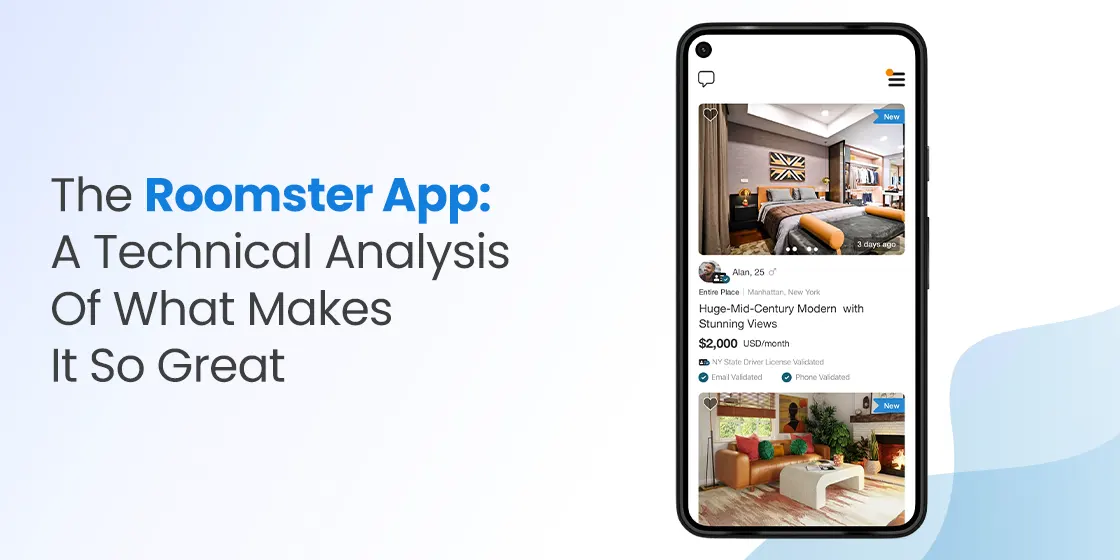Table of Content
Discover the Lessons App Developers Can Learn From the Roomster App’s Success
What makes a roommate-finding application scale to 5 million downloads and operate across 192 countries? The Roomster app represents one of the most successful examples of cross-platform real estate technology, combining sophisticated backend architecture with user-friendly mobile interfaces. Since its launch in 2003, this platform has evolved into a complex system that handles millions of listings and connects users worldwide through advanced matching algorithms and robust infrastructure.
The technical journey of the Roomster app offers valuable insights for developers looking to build scalable rental platforms. From its initial web-based architecture to the current mobile-first approach, Roomster demonstrates how proper technology choices, microservices architecture, and thoughtful user experience design can create lasting success in the competitive real estate technology market.
Understanding the technicalities of successful apps like Roomster provides developers with practical knowledge about building systems that can handle high user loads, complex search requirements, and real-time communication features. And it does so while maintaining security and performance standards expected in modern mobile applications. Let’s take a look at it in detail from the perspective of mobile app development services today.
Architecture Overview: Building a Scalable Rental Platform
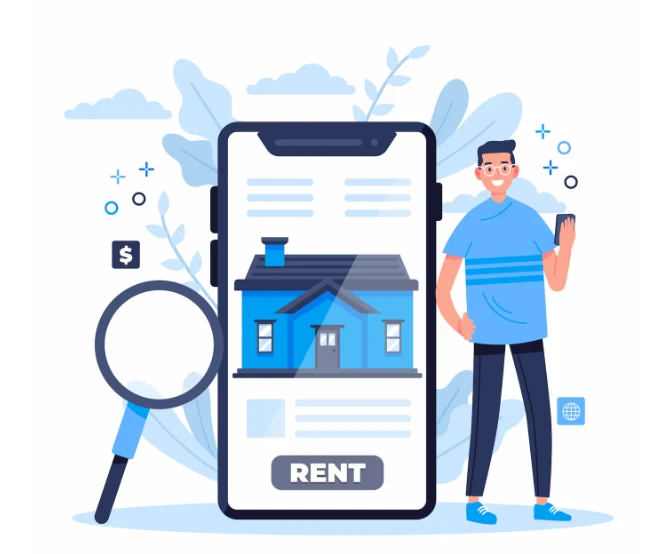
The Roomster app operates on a sophisticated multi-platform architecture designed to handle massive scale and global distribution. It has 5+ million active listings in different countries worldwide and 3+ million active users every month. It has a website built with .NET, Python, and ReactJS, as well as native mobile applications for iOS and Android. This hybrid approach allows the platform to leverage the strengths of different technologies while maintaining consistency across all user touchpoints.
The application’s architecture follows modern microservices principles, enabling independent scaling of different system components in real estate app development. The backend infrastructure utilizes a combination of .NET for core business logic, Python for data processing and machine learning algorithms, and ReactJS for dynamic web interfaces. This technology stack provides the flexibility needed to handle diverse requirements ranging from user authentication to complex geospatial searches.
The technical team behind Roomster has implemented what they describe as a “fast yet flexible geospatial search using open-source location data.” They created their internal city (state, block, room, etc.) IDs and mapped them to external ones (coming from Pelias). It allowed them to get rid of data duplication while interacting with the current API and with any other geocoder in the future. This approach demonstrates how careful architectural decisions can provide both immediate functionality and future flexibility.
Mobile Development Strategy: Cross-Platform Excellence
The Roomster app development strategy focuses on delivering native experiences across multiple platforms while maximizing code reuse and development efficiency. Roomster is the most popular and most download roommate finder app with 10M+ Downloads and 20M+ accounts, indicating the success of their mobile-first approach in capturing and retaining users across different mobile ecosystems.
For developers considering similar applications, the Roomster mobile strategy offers important lessons about balancing native performance with development efficiency. The application maintains separate native codebases for iOS and Android while sharing backend services and business logic. This approach ensures optimal performance and user experience on each platform while avoiding the potential limitations of hybrid frameworks for complex real estate applications.
The mobile development process for applications like Roomster typically involves careful consideration of platform-specific design patterns, navigation structures, and user interaction models. iOS applications leverage UIKit components and follow Human Interface Guidelines, while Android versions utilize Material Design principles and Android-specific navigation patterns. This platform-specific approach helps ensure that users feel comfortable with familiar interface elements and interaction patterns.
Backend Infrastructure: Microservices and Data Management
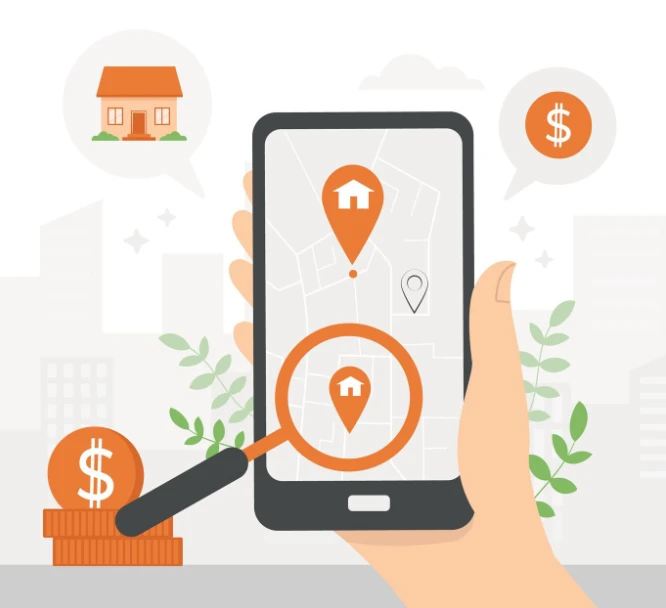
The backend architecture of the Roomster app demonstrates sophisticated engineering approaches to handling complex real estate data and user interactions. Let’s start with ElasticSearch, which was definitely the best choice for a high-load search. It allowed using both simple city IDs (just integers) and geopoints for fully-fledged geospatial search. This technology choice reflects the importance of selecting appropriate tools for specific technical requirements rather than following generic recommendations.
ElasticSearch serves as the core search engine, enabling the complex filtering and matching capabilities that make Roomster effective for users. The system handles multiple search parameters including location, price range, lifestyle preferences, and compatibility factors. The integration of geospatial search capabilities allows users to find accommodations within specific geographic boundaries while maintaining high performance even with millions of listings in the database.
By adding Kubernetes, as the most mature enterprise-ready orchestration system, the dev team managed to install the most configurable container orchestration system for microservices. The adoption of Kubernetes demonstrates the platform’s commitment to modern DevOps practices and scalable infrastructure management. This containerization approach enables the platform to scale individual services based on demand, maintain high availability, and deploy updates without system-wide downtime. Today this is a common theme when you build a real estate app like Dubai REST.
Database Design and Data Architecture
Effective data architecture forms the foundation of any successful rental platform, and the Roomster app showcases several important database design principles. The platform must handle diverse data types including user profiles, property listings, messaging histories, and complex relationship mappings between users and accommodations. This complexity requires careful consideration of data modeling, indexing strategies, and query optimization techniques.
The application implements a multi-database approach where different data types are stored in systems optimized for specific use cases. User profile data, property listings, and transactional information likely reside in traditional relational databases that provide ACID compliance and strong consistency guarantees. Meanwhile, search indices and real-time features utilize specialized systems like ElasticSearch and potentially NoSQL databases for optimal performance.
Geographic data represents a particular challenge for rental platforms, requiring specialized indexing and query capabilities. The Roomster platform’s approach to mapping internal location IDs to external geocoding services demonstrates the importance of creating abstraction layers that can adapt to different data sources while maintaining consistent internal data structures. This design pattern enables the system to switch between different geocoding providers without requiring extensive application changes.
Search and Matching Algorithms
The core value proposition of the Roomster app lies in its ability to effectively match users with compatible living situations. The app has functions such that you can filter through lifestyle, location, budget, habits such as smoking, late working, and other things. This matching functionality requires sophisticated algorithms that can process multiple criteria simultaneously while providing relevant results in real-time.
The search system must handle both hard constraints (location, price range, availability dates) and soft preferences (lifestyle compatibility, personal interests, living habits). Machine learning algorithms likely analyze user behavior patterns, successful matches, and feedback data to continuously improve recommendation quality. This approach allows the platform to learn from user interactions and provide increasingly relevant suggestions over time.
Performance optimization becomes critical when dealing with large-scale search operations. The integration of ElasticSearch enables the platform to handle complex queries involving multiple parameters while maintaining sub-second response times. Proper index design, query optimization, and caching strategies ensure that users receive quick results even when searching through millions of listings across multiple geographic regions.
Real-Time Communication Features
Modern rental platforms require robust communication systems to facilitate interactions between potential roommates and property owners. Its in-app messaging section gives easy and secure communication with potential flatmates. The Roomster app implements comprehensive messaging functionality that enables users to communicate safely within the platform while maintaining privacy and security.
The messaging system must handle real-time message delivery, message persistence, user presence indicators, and notification management across multiple platforms. WebSocket connections or similar real-time protocols enable instant message delivery, while message queuing systems ensure reliable delivery even when users are offline. Push notification services coordinate with mobile operating systems to alert users of new messages and important updates.
Security considerations play a crucial role in communication system design. Messages must be encrypted both in transit and at rest, user identity verification helps prevent fraud, and content moderation systems help maintain community standards. The platform likely implements rate limiting, spam detection, and abuse reporting mechanisms to protect users from harassment and maintain a positive community environment.
Security Implementation and Data Protection
Security represents a critical concern for rental platforms handling sensitive personal and financial information. The Roomster app has implemented comprehensive security measures, including recent enhancements focused on user verification and data protection. To further enhance security, certain features are now exclusively available to users who complete ID check & address check. This approach demonstrates how platforms can use progressive verification to build trust while maintaining usability.
Data encryption strategies must address multiple scenarios including data at rest, data in transit, and data in processing. Modern applications typically implement end-to-end encryption for sensitive communications, utilize HTTPS for all network communications, and employ database-level encryption for stored user information. Key management systems ensure that encryption keys are properly rotated and protected from unauthorized access.
The Company will also retain Usage Data for internal analysis purposes. Usage Data is generally retained for a shorter period of time, except when this data is used to strengthen the security or to improve the functionality of Our Service, indicating the platform’s approach to balancing data utility with privacy protection. Compliance with regulations like GDPR requires careful data governance policies that specify retention periods, deletion procedures, and user rights regarding their personal information.
Performance Optimization Strategies
Scalability and performance optimization represent ongoing challenges for applications serving millions of users globally. The Roomster app must handle varying load patterns, geographic distribution, and diverse usage scenarios while maintaining consistent performance. Content delivery networks (CDNs) help distribute static content closer to users, reducing latency and improving loading times for images and application assets.
Database optimization strategies include proper indexing, query optimization, connection pooling, and read replica distribution. Complex queries involving geospatial data and multiple filtering criteria require careful index design to avoid performance bottlenecks. Caching layers at multiple levels (application cache, database query cache, CDN edge cache) help reduce response times and decrease load on backend services.
Monitoring and observability tools provide crucial insights into application performance and user behavior. Application performance monitoring (APM) solutions help identify bottlenecks, track error rates, and measure user experience metrics. Real-time monitoring enables rapid response to performance issues and helps inform capacity planning decisions as the platform continues to scale.
Development Workflow and DevOps Practices
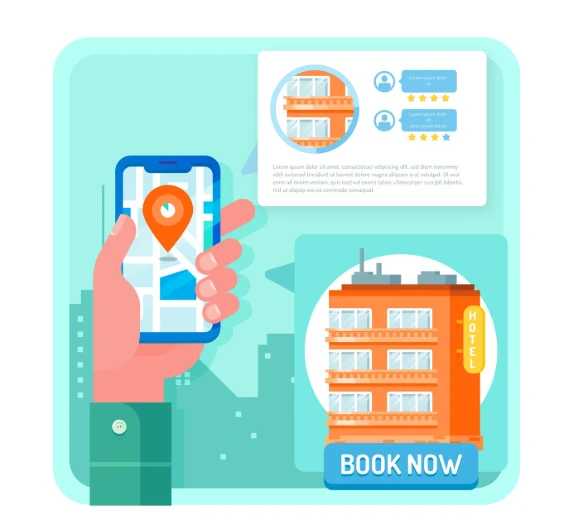
Modern application development requires sophisticated tooling and processes to maintain code quality while enabling rapid iteration and deployment. The Roomster app development team likely utilizes continuous integration and continuous deployment (CI/CD) pipelines to automate testing, building, and deployment processes. These practices enable the team to deliver updates frequently while maintaining system stability and reliability.
Code quality assurance involves multiple layers including automated testing, code review processes, and static analysis tools. Unit tests validate individual component functionality, integration tests verify system interactions, and end-to-end tests ensure complete user workflows function correctly. Mobile applications require additional testing considerations including device compatibility, operating system versions, and app store approval processes.
Version control strategies must accommodate multiple development teams working on different platform versions simultaneously. Feature branching, automated merging, and deployment strategies help coordinate changes across web, iOS, and Android versions while minimizing conflicts and ensuring consistent functionality across all platforms.
Scaling Challenges and Solutions
Operating a platform with millions of users across hundreds of countries presents unique scaling challenges that require thoughtful architectural decisions. Roomster connects people at all price points, in 192 countries. With 24/7 customer service and an always expanding community of users, Roomster is the best way for people to monetize their extra space. This global reach requires infrastructure capable of handling diverse geographic, linguistic, and regulatory requirements.
Horizontal scaling strategies enable the platform to handle increased load by adding more servers rather than upgrading existing hardware. Microservices architecture facilitates this approach by allowing individual services to scale independently based on demand patterns. Load balancing distributes incoming requests across multiple server instances, while auto-scaling policies automatically adjust capacity based on current usage levels.
Geographic distribution requires careful consideration of data sovereignty laws, latency requirements, and regional preferences. Multi-region deployments help ensure low latency for users worldwide while providing disaster recovery capabilities. However, distributed systems introduce complexity around data consistency, cross-region communication, and coordinated deployments that must be carefully managed.
Technology Stack Analysis
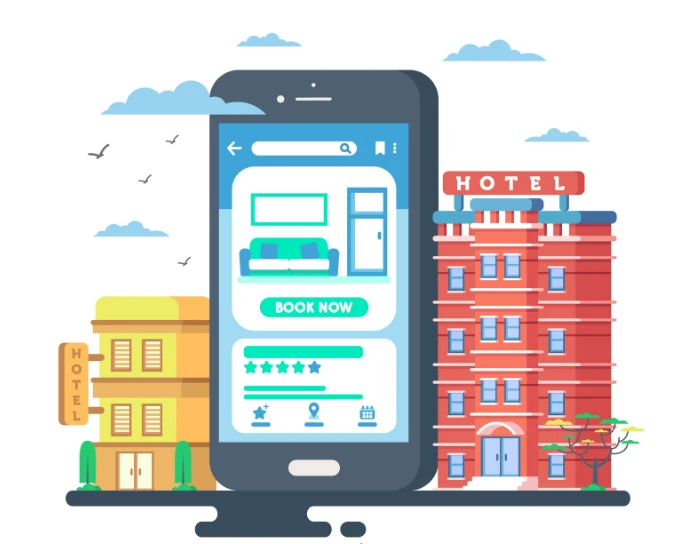
The Roomster app technology stack reflects modern best practices for building scalable web and mobile applications in the room and hotel booking apps niche. The combination of .NET, Python, and ReactJS provides flexibility for different system components while leveraging the strengths of each technology. .NET offers enterprise-grade reliability and performance for core business logic, Python excels at data processing and machine learning tasks, and ReactJS enables dynamic and responsive user interfaces.
Database technology choices likely include relational databases for transactional data, NoSQL systems for flexible schema requirements, and specialized search engines for complex query operations. This polyglot persistence approach allows each data type to be stored in the most appropriate system while maintaining overall system coherence through well-defined APIs and data integration patterns.
Infrastructure components include container orchestration with Kubernetes, message queuing systems for asynchronous processing, caching layers for performance optimization, and monitoring systems for operational visibility. Cloud platform services provide managed infrastructure components, reducing operational overhead while enabling rapid scaling and global distribution.
Future Development Trends
The rental platform industry continues to evolve with new technologies and changing user expectations. Artificial intelligence and machine learning capabilities will likely become more sophisticated, enabling better matching algorithms, personalized recommendations, and automated content moderation. Computer vision technology might help verify property photos and detect fraudulent listings automatically.
Blockchain technology could provide new approaches to identity verification, payment processing, and trust establishment between users. Smart contracts might automate certain aspects of rental agreements while providing transparency and reducing disputes. However, these technologies must be evaluated carefully for practical benefits rather than adopting them simply because they’re innovative.
Mobile platform evolution will continue to influence application development strategies. New operating system features, hardware capabilities, and user interface paradigms require ongoing adaptation to maintain competitive advantage. Progressive web application technologies might enable new approaches to cross-platform development while maintaining native performance and user experience quality.
Frequently Asked Questions
| What technology stack does the Roomster app use for its backend infrastructure? The Roomster app utilizes a modern multi-technology stack including .NET for core business logic, Python for data processing and machine learning, and ReactJS for web interfaces. The platform also leverages ElasticSearch for high-performance search capabilities and Kubernetes for container orchestration, enabling scalable microservices architecture. |
| How does Roomster handle geospatial search across millions of property listings? Roomster implements a sophisticated geospatial search system using ElasticSearch with both simple city IDs and geopoints for location-based queries. They created internal mapping systems that connect to external geocoding services like Pelias, allowing for flexible data integration while maintaining high performance for location-based searches across 192 countries. |
| What are the key security measures implemented in the Roomster app? Roomster has implemented comprehensive security measures including mandatory ID verification and address checks for accessing certain features, end-to-end encryption for communications, and secure data handling practices compliant with privacy regulations like GDPR. The app also includes spam detection, fraud prevention, and 24/7 customer service to maintain platform security. |
| How does the Roomster app architecture support scaling to millions of users? The platform uses microservices architecture with Kubernetes orchestration, enabling independent scaling of different system components. This includes horizontal scaling strategies, load balancing, multi-region deployments, and specialized databases for different data types. The containerized approach allows for efficient resource utilization and automatic scaling based on demand. |
| What development challenges are unique to building rental platform apps like Roomster? Key challenges include implementing complex matching algorithms that consider multiple user preferences, handling real-time messaging at scale, managing geospatial data across global markets, ensuring regulatory compliance across different jurisdictions, and building trust mechanisms for user safety. Additionally, developers must balance feature richness with mobile performance constraints while maintaining consistent experiences across platforms. |
Conclusion
The Roomster app demonstrates how thoughtful technology choices, proper architectural patterns, and focus on user experience can create successful platforms that serve millions of users globally. Key lessons include the importance of selecting appropriate technologies for specific requirements rather than following trends, the value of microservices architecture for enabling independent scaling, and the necessity of comprehensive security measures for building user trust.
Developers building similar platforms should focus on understanding their specific requirements before selecting technologies, invest in proper testing and monitoring infrastructure from the beginning, and design systems with scalability in mind even if initial user bases are small. The rental platform market continues to offer opportunities for innovative solutions that solve real user problems through effective technology implementation.
Success in this space requires balancing technical excellence with deep understanding of user needs, regulatory requirements, and market dynamics. The Roomster app provides a valuable case study in how these elements can be combined to create platforms that deliver lasting value to users while maintaining technical excellence and operational efficiency.

Empower your digital journey with StruqtIO - Your dedicated partner for cutting-edge custom software development, innovation, and digital transformative solutions. Harness the power of technology to elevate your business and redefine your digital landscape today.
